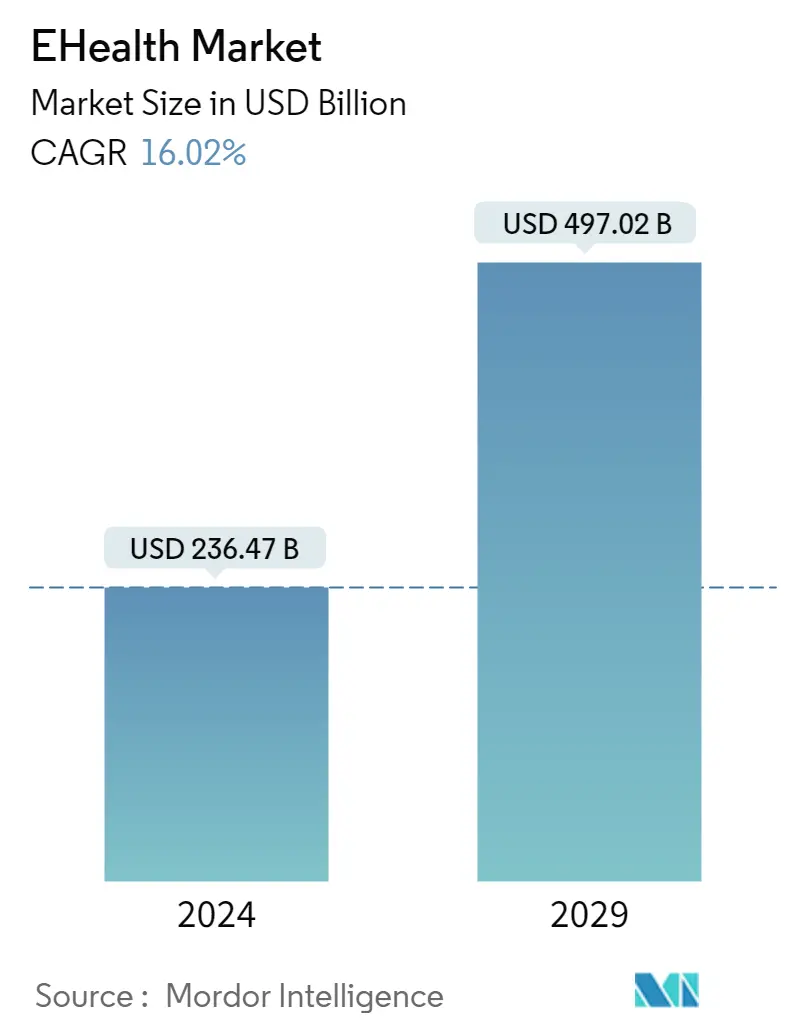Market Size of EHealth Industry

| Study Period | 2019 - 2029 |
| Market Size (2024) | USD 236.47 Billion |
| Market Size (2029) | USD 497.02 Billion |
| CAGR (2024 - 2029) | 16.02 % |
| Fastest Growing Market | Asia Pacific |
| Largest Market | North America |
Major Players
*Disclaimer: Major Players sorted in no particular order |
Need a report that reflects how COVID-19 has impacted this market and its growth?
eHealth Market Analysis
The EHealth Market size is estimated at USD 236.47 billion in 2024, and is expected to reach USD 497.02 billion by 2029, growing at a CAGR of 16.02% during the forecast period (2024-2029).
COVID-19 has impacted the eHealth market owing to market players' increased launches of telemedicine and other eHealth solutions for COVID-19 contact tracing and consultations during the isolation period. For instance, according to an article published in the International Journal of Medical Informatics in June 2022, an online survey of Japanese healthcare providers carried out from January 25 to February 22, 2021, reported that 73.3% of care delivery institutions used electronic medical records and 57.8% of the EMRs were connected to an external network that helps in sharing the regional health information with other hospitals (22.0%), report online medical insurance claims (27.5%), and conduct intrahospital system maintenance (61.5%). Hence, the use of e-health was at its peak during the pandemic. The eHealth market is growing due to its increasing adoption because of COVID-19 and is expected to register a significant growth rate during the forecast period.
The propelling factors for the growth of the e-health market include the growth in IoT and technological innovations, rising preference toward mobile technology and the internet, and rising demand for population health management. For instance, according to an article published in Digital Health in August 2022, the digital health transition in numerous healthcare facilities throughout Saudi Arabia was assessed utilizing digital health indicators. The total digital transformation score in private healthcare facilities was observed to be higher than in governmental hospitals due to greater implementation rates. Thus, the high adoption of digital health systems across private healthcare facilities is expected to increase market growth over the forecast period.
The government initiatives for the rising preference toward mobile technology and the internet are also expected to propel market growth. For instance, in May 2022, Israel approved 19 initiatives for USD 30 million for a new digital health initiative enabling healthcare institutions, including HMOs, hospitals, and institutes, to develop the digital infrastructure needed for collaborative R&D projects with start-ups in the field of healthcare.
The technological advancement in e-health solutions, product launches, and partnerships by market players is expected to propel market growth during the forecast period. For instance, in May 2022, Brazil's digital health company, Memed, launched a set of digitally integrated care pathways that allow patients to purchase medication online directly from a Memed e-prescription. Furthermore, in January 2022, Visionflex partnered with MediRecords, Australia's cloud-based electronic medical record and practice management systems provider. The partnership is aimed to integrate Visionflex's video conferencing platform, Vision, with MediRecords' cloud-based electronic health record and practice management software platforms.
Therefore, the studied market is anticipated to witness growth over the analysis period due to the factors such as rising launches, partnerships, and fundraising for the expansions of eHealth solutions by market players. However, the concerns over data security, the lack of reimbursement policies in emerging markets, and the lack of proper infrastructure for eHealth in emerging markets are estimated to restrain the market growth.
